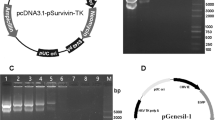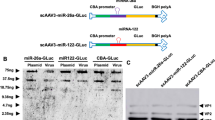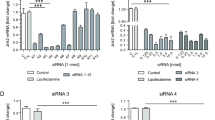Abstract
Metalloproteinases (MMPs) and their natural inhibitors (TIMPs) contribute to the regulation of tumor microenvironment. Their expressions are deregulated in almost all human cancers. We report a novel approach to gene therapy of hepatocellular carcinoma (HCC), using repeated injections of DNA plasmids encoding the tissue inhibitors of metalloproteinases (TIMPs) TIMP-2 or TIMP-3, and a novel competent formulation of gene transfer based on nontoxic cationic cholesterol derivatives. The new gene delivery system was efficient in demonstrating the antitumor efficiency of TIMP-2 or TIMP-3 in inhibiting tumor growth of human HuH7 HCC cells xenografted into nude mice. We show, for the first time, an in vivo effect of TIMP-3 in delaying HCC tumor growth. No treatment-related toxicity was noted. An inhibition of angiogenesis and tumor necrosis accompanied the inhibitory effects of TIMP-2 or TIMP-3 on tumor expansion and invasion. We also report a bystander effect produced by transfected HuH7 tumor cells mixed with untransfected cells in 1:1 ratio in culture that resulted in killing 98% of cells within 96 h. In addition, the soluble forms of TIMP-2 and TIMP-3 expressed by transfected cells exerted a cytotoxic effect on untransfected HuH7 cell cultures. Taken together, these results demonstrate the potential efficacy of repeated treatment of secreted TIMP-2 and TIMP-3 for the design of nonviral gene therapy for hepatocarcinoma.
This is a preview of subscription content, access via your institution
Access options
Subscribe to this journal
Receive 12 print issues and online access
$259.00 per year
only $21.58 per issue
Buy this article
- Purchase on Springer Link
- Instant access to full article PDF
Prices may be subject to local taxes which are calculated during checkout







Similar content being viewed by others
References
Deuffic S, Poynard T, Buffat L, et al. Trends in primary liver cancer. Lancet. 1998;351:214–216.
El-Serag HB, Mason AC . Rising incidence of hepatocellular carcinoma in the United States. N Engl J Med. 1999;340:745–750.
Takayama T, Makuuchi M, Hirohashi S, et al. Early hepatocellular carcinoma as entity with a high rate of surgical cure. Hepatology 1998;28:1241–1246.
Mazzaferro V, Regalia E, Doci R, et al. Liver transplantation for the treatment of small hepatocellular carcinomas in patients with cirrhosis. N Engl J Med. 1996;334:693–699.
Livraghi T, Giorgio A, Marin G, et al. Hepatocellular carcinomas and cirrhosis in 746 patients:long term results of percutaneous ethanol injection. Radiology. 1995;197:101–108.
Pelletier G, Ducreux M, Gay F, et al. Treatment of unsectable hepatocellular carcinoma with lipiodol chemoembolization:a multicenter randomized trial. J Hepatol. 1998;29:129–134.
Nilsson L, Rudenstam CM, Zettergren L . Vascularization of liver tumors and the effect of hepatic artery ligature. Bibl Anat. 1967;9:45–49
Breedis C, Young G . Blood supply of neoplasms in the liver. Am J Pathol. 1954;30:969–985.
Gerolami R, Cardoso J, Bralet M-P, et al. Enhanced in vivo adenovirus-mediated gene transfer to rat hepatocarcinomas by selective administration into the hepatic artery. Gene Ther. 1998;5:896–904.
Gerolami R, Cardoso J, Lewin, et al. Evaluation of HSV-tk gene therapy in a rat model of chemically induced hepatocellular carcinoma by intratumoral and intrahepatic artery routes. Cancer Res. 2000;60:993–1001.
Sa Cunha A, Bonte E, Dubois S, et al. Inhibition of rat hepatocellular carcinoma tumor growth after multiple infusions of recombinant Ad.AFPtk followed by ganciclovir treatment. J Hepatol. 2002;37:222–230.
Tran PL, Sa Cunha A, Virone A, et al. In vivo antitumor efficacy of Ad5CMV-p53 in a rat model of chemically-induced hepatocellular carcinoma after a single intra-tumor injection or multiple infusions by intra-hepatic artery route. Proc Am Ass Cancer Res. 1999;40:3910.
Egeblad M, Werb Z . New functions for the matrix metalloproteases in cancer progression. Nat Rev Cancer. 2002;2:163–176.
Gomez DE, Alonso DF, Yoshiji H, et al. Tissue inhibitors of metalloproteinases:structure, regulation and biological functions. Eur J Cell Biol. 1997;74:111–122.
Werb Z . ECM cell surface proteolysis and regulating cellular ecology. Cell. 1997;91:439–442.
Brooks PC, Stromblad S, Sanders LC, et al. Localization of matrix metalloproteinase MMP-2 to the surface of invasive cells by interaction with integrin ανβ3. Cell. 1996;85:683–693.
Brooks PC, Silletti S, von Schalscha TL, et al. Disruption of angiogenesis by PEX, a noncatalytic metalloproteinase fragment with integrin binding activity. Cell. 1998;92:391–400.
Amour A, Slocombe PM, Webster A, et al. TNF-alpha converting enzyme (TACE) is inhibited by TIMP-3. FEBS Lett. 1998;435:39–44.
Amour A, Knight CG, Webster A, et al. The in vitro activity of ADAM-10 is inhibited by TIMP-1 and TIMP-3. FEBS Lett. 2000;473:275–279.
Kashiwagi M, Tortorella M, Nagase H, et al. TIMP-3 is a potent inhibitor of aggrecanase 1 (ADAM-TS4) and aggrecanase 2 (ADAM-TS5). J Biol Chem. 2001;276:12501–12504.
Ahonen M, Baker AH, Kähäri V-M . Adenovirus-mediated gene delivery of tissue inhibitor of metalloproteinases-3 inhibits invasion and induces apoptosis in melanoma cells. Cancer Res. 1998;58:2310–2315.
Baker AH, George SJ, Zaltsman AB, et al. Inhibition of invasion and induction of apoptotic cell death of cancer cell lines by overexpression of TIMP-3. Br J Cancer. 1999;79:1347–1355.
Bond M, Murphy G, Bennett MR, et al. Localization of the death domain of tissue inhibitor of metalloproteinases-3 to the N terminus. J Biol Chem. 2000;52:4358–4363.
Lehn JM, Lehn P, Vigneron JP . Compounds related to the amidinium family, pharmaceutical compositions containing same, and uses thereof. Patent 6143729, 2000.
Tran PL, Weinbach J, Opolon P, et al. Prevention of bleomycin-induced pulmonary fibrosis after adenovirus-mediated transfer of the bacterial bleomycin resistance gene. J Clin Invest. 1997;99:608–617.
Vigneron J-P, Oudrhiri N, Fauquet M, et al. Guanidinium-cholesterol cationic lipids:efficient vectors for the transfection of eukaryotic cells. Proc Natl Acad Sci USA. 1996;93:9682–9686.
Brand K, Baker AH, Perez-Canto A, et al. Treatment of colorectal liver metastases by adenoviral transfer of tissue inhibitor of metalloproteinases-2 in the liver tissue. Cancer Res. 2000;60:5273–5730.
Giannelli G, Bergamini C, Fransvea E, et al. Human hepatocellular carcinoma (HCC) cells require both α3β1 integrin and matrix metalloproteinases activity for migration and invasion. Lab Invest. 2001;81:8613–8627.
Laemmli UK . Cleavage of structural proteins during assembly of the head of bacteriophage T4. Nature. 1970;227:680–685.
Pitard B, Oudhrhiri, Lambert O, et al. Sterically stabilized BGTC-based lipoplexes:structural features and gene transfection into the mouse airways in vivo. J Gene Med. 2001;3:478–487.
DeClerk YA, Perez N, Shimada H, et al. Inhibition of invasion and metastasis in cells transfected with an inhibitor of metalloproteinases. Cancer Res. 1992;52:701–708.
Roth JA, Nguyen D, Lawrence DD, et al. Retrovirus-mediated wild-type p53 gene transfer to tumors of patients with lung cancer. Nat Med. 1996;2:985–981.
Bao J-J, Zhang W-W, Kuo MT . Adenoviral delivery of recombinant DNA into transgenic mice bearing hepatocellular carcinomas. Hum Gene Ther. 1996;7:355–365.
Anderson SC, Johnson DE, Harris MP, et al. p53 Gene therapy in a rat model of hepatocellular carcinoma:Intra-arterial delivery of recombinant adenovirus. Clin Cancer Res. 1998;4:1649–1659.
Leeson-Wood LA, Kim WH, Kleinman HK, et al. Systemic gene therapy with p53 reduces growth and metastases of a malignant human breast cancer in nude mice. Hum Gene Ther. 1995;6:395–405.
Kaneko S, Hallenbeck P, Kotani T, et al. Adenovirus-mediated gene therapy of hepatocellular carcinoma using cancer-specific gene expression. Cancer Res. 1995;55:5283–5287.
Qian C, Idoate M, Bilbao R, et al. Gene transfer and therapy with adenoviral vector in rats with diethylnitrosamine-induced hepatocellular carcinoma. Hum Gene Ther. 1997;8:349–358.
Habib NA, Sarraf CE, Mitry RR, et al. E1B-deleted adenovirus (dl520) gene therapy for patients with primary and secondary liver tumors. Hum Gene Ther. 2001;12:219–226.
Fidler IJ . Modulation of the organ microenvironment for treatment of cancer metastasis. J Natl Cancer Inst. 1995;87:1588–1592.
Boudreau N, Bissell MJ . Extracellakular matrix signaling: integration of form and function in normal and malignat cells. Curr Opin Cell Biol. 1998;10:640–646.
Egeblad M, Werb Z . New functions for the matrix metalloproteinases in cancer progression. Nat Rev Cancer. 2002;2:163–176.
Li H, Lindenmeyer F, Grenet C, et al. AdTIMP-2 inhibits tumor growth, angiogenesis, and metastasis, and prolongs survival in mice. Hum Gene Ther. 2001;12:515–526.
Ahonen M, Ala-Aho R, Baker AH, et al. Antitumor activity and bystander effect of adenovirally delivered tissue inhibitor of metalloproteinases-3. Mol Ther. 2002;5:705–715.
Giannelli G, Bergamini C, Marinosci F, et al. Clinical role of MMP-2/TIMP-2 imbalance in hepatocellular carcinoma. Int J Cancer. 2002;97:425–431
Acknowledgements
We thank Drs J-C Ehrhart, M. Buckle, and J-R Bertrand for critical reading of the manuscript, Professor J-M Lehn and Dr P Lehn for discussions, and A Rouchès and P Ardouin (Laboratoire d'Expérimentation Animale) for technical support.
Author information
Authors and Affiliations
Corresponding author
Rights and permissions
About this article
Cite this article
Tran, PL., Vigneron, JP., Pericat, D. et al. Gene therapy for hepatocellular carcinoma using non-viral vectors composed of bis guanidinium-tren-cholesterol and plasmids encoding the tissue inhibitors of metalloproteinases TIMP-2 and TIMP-3. Cancer Gene Ther 10, 435–444 (2003). https://doi.org/10.1038/sj.cgt.7700592
Received:
Published:
Issue Date:
DOI: https://doi.org/10.1038/sj.cgt.7700592
Keywords
This article is cited by
-
TIMP-3 -1296 T>C and TIMP-4 -55 T>C gene polymorphisms play a role in the susceptibility of hepatocellular carcinoma among women
Tumor Biology (2014)
-
Inhibition of tumor growth and induction of apoptosis in prostate cancer cell lines by overexpression of tissue inhibitor of matrix metalloproteinase-3
Cancer Gene Therapy (2010)
-
Inhibition of human leukemia xenograft in nude mice by adenovirus-mediated tissue inhibitor of metalloproteinase-3
Leukemia (2006)



